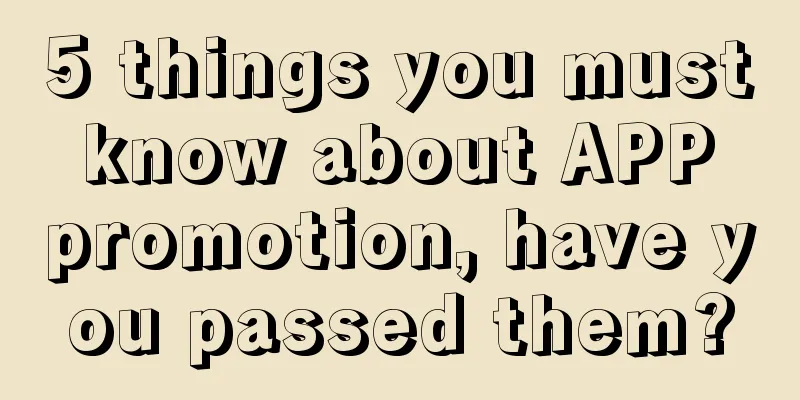Product operation and promotion: How to compete for traffic?

|
Recently, more and more people around me are talking about traffic. Exchange meetings related to traffic are crowded with people. You will find that everyone looks confused and has desire in their eyes. When you ask, they basically come to look for traffic. E-commerce merchants are more eager for traffic. For them, no amount of traffic is too much, especially now that the cost of acquiring customers on various e-commerce platforms is getting higher and higher. Brands are constantly paying attention to channels outside e-commerce platforms such as Douyin, Kuaishou, WeChat, and Weibo, and understanding private domain traffic construction forms such as social e-commerce, community e-commerce, and live streaming, hoping to find more incremental traffic and increase sales. In the overall environment, traffic is becoming more and more expensive. In recent years, the entrepreneurial idea of the Internet has been "first attract traffic, and then consider the issue of monetization", which has led to the competition for Internet traffic being based on burning money, and finally inevitably asking the giants for help and standing in line, which has accelerated the speed at which traffic gathers in the hands of the giants, and the cost of acquiring traffic has only increased. Taking New Retail as an example Everyone is looking for traffic pools. A Douyin video can attract hundreds of thousands of fans, and a live broadcast can sell millions of goods, which has led to e-commerce people rushing to new platforms, hoping to reap the benefits of the platform and replicate the miracle of attracting fans. In fact, people have always been anxious about traffic. In the portal era more than a decade ago, people complained that all the traffic was sucked away by portal websites. In the search engine era, people complained that all the traffic was bought by wealthy brands through bidding. However, every year some super apps are born and many new brands emerge. Especially in the past two years, various niche brands have appeared in everyone's vision, and various individual entrepreneurs with annual incomes of tens of millions or even hundreds of millions have continued to fill the headlines of the media. 1. What is traffic? Traffic, that is, consumers’ attention, is the guarantee of sales. When we talk about traffic, we must focus on accurate traffic, which is especially important for e-commerce merchants whose purpose is sales. For example: A girl who sells women's underwear records and posts short videos on Douyin, showing off her figure and beautiful breasts. She gains a lot of fans through Douyin every day, but the sales of her underwear do not increase. Although there is continuous traffic for girls, they are basically all men, so there will naturally be no sales conversion. Such traffic, no matter how much it there is, is meaningless. Whether online or offline, the same feature is the demand for traffic. Offline, merchants like to find locations with high traffic if rent allows. According to the funnel principle, the greater the traffic, the more people will buy their products. The biggest variable that determines the traffic of offline commercial entities is the distribution of surrounding public facilities and the location of the commercial entity. The rental cost corresponding to the traffic flow is the customer acquisition cost of the offline commercial entity. The difference between online and offline platforms is that offline businesses acquire traffic passively, while e-commerce platforms are more proactive in acquiring traffic because online traffic can be "purchased" and "exchanged". As long as the monetization value of the traffic is higher than the purchase price, continuous traffic purchases are a cost-effective business. Therefore, platforms with advantages in traffic management efficiency can continuously expand their scale boundaries and consolidate their leading position. 2. E-commerce traffic history The history of e-commerce platforms’ demand for traffic is actually a brief history of traffic in China’s Internet over the past 20 years. Take Alibaba as an example. In the nearly 20 years from 2000 to now, the dominant source of traffic has shifted from portals to search engines, social applications, and content communities. Alibaba has never been at the center of the traffic tide. Traffic acquisition and operation are important topics for Alibaba, and have also created Alibaba and e-commerce merchants' amazing traffic research and acquisition capabilities. 1. Portal Era: In the portal era, portal websites are the largest traffic entrances. If you can control the portal websites, you can almost control the Internet traffic. Many people born in the 1990s may be unfamiliar with the name EachNet, but in 2003, it was the leading C2C e-commerce platform in China, invested by eBay of the United States, and was very awesome. Taobao went online in 2003. That year, its market share was only 7.8%, while Eachnet’s was over 90%. Relying on its wealth, Eachnet signed exclusive advertising agreements with portal websites such as Sina, Sohu, and NetEase. Take my former employer Sina as an example, its online advertising revenue soared from US$20 million in 2003 to US$81.45 million in 2005, with an annual growth rate of 48.8%. During the same period, Sohu and NetEase's online advertising revenue grew at an annualized rate of 72.3% and 91.8% respectively. Fortunately, in addition to portal website traffic, there were also a large number of active individual webmasters from 2003 to 2005. Taobao came up with a surprising strategy, purchasing large amounts of fragmented traffic from individual webmasters and at the same time implementing a free strategy for sellers, thus ensuring a continuous source of traffic for Taobao. In 2005, its market share reached 70%, successfully surpassing EachNet. 2. Search Era: With information overload, people began to rely on search engines. Since 2006, Baidu has topped the list in terms of average daily IP volume for many consecutive years. Alibaba acquired Yahoo in the hope of making progress on the search side, but for various reasons, the acquired Yahoo did not meet expectations. In 2008, Baidu launched its own e-commerce platform "Youa", hoping to form a closed loop from traffic entry to traffic harvesting and monetization. However, Baidu focused on the front-end user interface and traffic optimization, and did not build supporting facilities such as merchant tools, logistics standards, evaluation systems, warehousing, etc. that are crucial for e-commerce. In less than three years, "Youa" lost in the competition with Alibaba. In the competition for traffic with Baidu, Alibaba is also actively seizing the initiative. In 2007, Alimama was launched, which is similar to Baidu's advertising alliance product. It connects merchants and small and medium-sized websites, realizes traffic monetization, accumulates small amounts into large amounts, and breaks away from the reliance on Baidu search traffic. In 2008, Alibaba took continuous actions to control traffic: it stopped advertising on all Baidu platforms, Taobao officially blocked Baidu search, Taobao and Alimama merged, and replenished traffic through small and medium-sized sites owned by Alimama. The Taobao Affiliate Platform was launched to help Taobao sellers connect with individuals to promote their products and earn CPS commissions based on transactions, thus maximizing the use of traffic. In the search era, Alibaba obtains external traffic through Taobao Alliance and Taobao Affiliate Platform, and brand merchants obtain internal traffic through Taobao Direct Express, Diamond Exhibition and other operational techniques. At that time, there were more porridge than monks, and the combination of paid and free traffic enabled many entrepreneurs to make their first pot of gold on Taobao. At the same time, there also emerged local information ports, BBSs, blogs, etc. For wealthy brands, this was a relatively good era. At that time, people’s immunity to advertising was relatively low, search traffic was not expensive, and the cost of acquiring accurate traffic was also low. SEO and SEM were very popular. Unlike now, the price of traffic remains high, accurate traffic is expensive and difficult to buy, consumers are becoming more and more averse to advertising, and conversion rates are getting lower and lower. As a result, many entrepreneurs today, in the early stages of their business, need to have not only traffic thinking but also brand thinking. 3. Social era: Weibo appeared in 2009 and swept the Chinese Internet at the speed of a storm. The four major portals, Baidu, Phoenix.com, and People.com.cn all joined the battlefield, and group buying subsequently triggered a war among thousands of groups. It is at this stage that many entrepreneurs’ desire for traffic reaches a crazy level. Alibaba people have always had a social dream. Although the "Laiwang" app that was intended to compete with WeChat did not take off, they invested in Sina Weibo, Momo, etc., especially Sina Weibo, which helped Alibaba a lot in terms of traffic. For e-commerce merchants, the emergence of Weibo has given them opportunities:
Although Weibo has been around for 10 years, e-commerce is still the most efficient way to monetize on Weibo. In 2018, the income of content authors enabled by Weibo reached 28.6 billion yuan, and e-commerce monetization reached 25.4 billion yuan. The internet celebrity economic model is a typical example of the cooperation between social and e-commerce platforms: Weibo completes the front-end customer acquisition, and the e-commerce platform completes the traffic monetization. Ruhnn, which went public this year, is the most successful representative of the internet celebrity economy. 4. Content Era: In 2017-2018, the demographic dividend ended, and the dominant player in the traffic market shifted from social products to content products, with search traffic, social traffic, and content traffic coexisting. Content channels such as Douyin, Kuaishou, Xiaohongshu, and WeChat official accounts are growing rapidly. People are no longer blindly pursuing growth. How to operate existing content has become a necessary skill for e-commerce merchants, forcing merchants to have the ability to acquire and operate refined traffic. As traffic trends concentrate on top content products, Alibaba has continuously invested in Xiaohongshu, Babytree, and Bilibili. In the future, the precise traffic from vertical communities will be monetized more efficiently on e-commerce platforms. At this time, the acquisition of incremental revenue is no longer based on online advertising, Baidu bidding, and DSP. KOL placement + PGC content production and distribution have become the norm. The concept of private domain traffic centered on refined traffic acquisition and operation has been proposed and has become the most popular means of increasing sales. 3. Private domain traffic This concept originated from Taobao. Private domain traffic means that the traffic belongs to the user and can be used repeatedly, free of charge and directly reaching users. Every bit of traffic is a user, and they are deposited on platforms such as WeChat public accounts, WeChat groups, WeChat personal accounts, Weibo, Xiaohongshu, Toutiao and Douyin. In contrast to the private traffic pool are public traffic platforms, such as large traffic platforms such as Baidu, Taobao and JD. All traffic has to be purchased with money, and it is getting more and more expensive. For example Public domain traffic is like the ocean. At the beginning, there are many fish but few fishermen. Even if you have average skills, you may get something. As more and more people fish, the cost of catching fish becomes higher and higher. So many people start to build their own fish ponds to raise fish. This reduces the cost of fishing and makes it easier to catch fish. We call the fish pond we build ourselves private domain traffic. Misconceptions about private domain traffic 1. Private domain traffic = micro-business? Many people think that to build a private traffic pool, they just need to cultivate WeChat accounts, cultivate 5,000 friends for each WeChat account, and post advertisements in the circle of friends, which will attract many friends to watch. Or you can create a group and split it to attract people. Indeed, establishing and maintaining your own WeChat group is very effective private domain traffic. If many groups work together, it can have a good effect on order conversion. This is the prototype of Wechat business, but private domain traffic is not equal to Wechat business. Now many people think of Wechat business when they talk about private domain traffic. If you still keep this kind of thinking, even if you want to do it, you will definitely not be able to do it well. The essential difference between private domain traffic and WeChat business The essence of Wechat business is to sell the dream of making money to everyone, and to achieve the circulation of high-profit margin products through agents and recruiting people. Most of the products are stored in the hands of agents at all levels, and advertisements are constantly posted in the circle of friends, attracting even more downstream customers than consumers. The products must be high-profit, high-frequency, and popular, such as facial masks and weight-loss pills. The core of private domain traffic is to operate and provide consumer value, narrowing the distance between brands and consumers. If you can’t wait to harvest it, unless your ability to attract new customers is very strong, such private domain traffic is meaningless. What we lack now is not how to create groups, but how to make groups active. Dead groups are worthless. 2. Are products with high unit prices and low repurchase rates not suitable for private domain traffic? People who think this way are still thinking at the level of selling goods on WeChat and lack operational thinking. I know a friend who sells jewelry. Jewelry is a product with a high average order value and a low repurchase rate. But he managed to make money by attracting fans through public accounts, gathering fans in WeChat groups, and sharing on Moments. He does online business and his wife does offline business. The offline store business is average, but the online business is booming. He has now developed a paid group. Fans buy his products and pay to join his group. This is where his operation is awesome. (Of course, I can't share his method hahaha) It’s not that it can’t be done, it’s just that many people haven’t found the right method. 4. Why is private domain traffic so powerful? 1. Improve consumers’ favorability and loyalty to the brand and increase sales conversion On e-commerce platforms, merchants and consumers can only complete one transaction, and once the transaction is completed, the connection with the consumer also ends. When you circle consumers, no matter it is a brand or an individual, it is no longer a cold account. Now everyone has been talking about personal setting, which is actually to build trust with consumers through personal setting. Without trust, there will be no business transactions. There are many ways to increase trust, and sending out advertisements crazily is the worst option. 2. Word-of-mouth communication, bringing in new customers with old customers at low cost The traffic that is gathered through various channels is actually backed by consumers who recognize the brand. Everyone has his or her own social circle, so when it comes to private traffic, what should be considered is word of mouth and sharing: 1. Word of mouth: Through brand incentives and leveraging consumers’ social relationship chains, word-of-mouth communication of products is achieved. 2. Sharing: Every consumer is a disseminator in their circle. In private domain traffic, it is easier to guide consumers to share products through incentives. Take beauty and skin care as an example Every girl who loves beauty is an expert with hundreds or thousands of friends in the circle of friends. She may be an amateur blogger on Weibo or Xiaohongshu. Through their spontaneous dissemination, she builds the brand's voice on the self-media platform. Many emerging brands do not have a particularly large marketing budget, but are worried about not being able to find KOLs for advertising. However, they do not realize that they are ignoring their consumers, who are the ones who understand the brand and are actually using the products. How to effectively stimulate consumers to spread the word is something that brands need to think about when generating private domain traffic. 3. Optimize products and provide product suggestions Often, when new products are launched, brands will conduct research through research agencies. Although this costs money, the research results may not necessarily represent real consumers. Now, through private domain traffic, brands can directly conduct surveys among consumer groups and then work backwards to the supply chain and products. This is efficient and effective, and most importantly, it saves research fees. 4. Clear inventory and sell off tail goods What are e-commerce companies afraid of? Afraid of inventory! Inventory in hand represents cash flow, especially when clothing merchants change seasons. Looking at a warehouse full of goods is like looking at a pile of unusable banknotes. Nowadays, many big brands are using Pinduoduo to sell off their inventory. Many small and medium-sized brands do not have many leftover goods and cash flow, so there is no need for them to go on Pinduoduo. Private domain traffic is the best place for them to clear inventory and do group buying. 5. How to establish private domain traffic? There are only a few ways to build private domain traffic:
For big brands, they rely on brand premium and have the effect of bringing their own traffic. People will go directly to their favorite brand stores to buy goods. They also have relatively abundant budgets, so it will be relatively easy to obtain traffic. If they accidentally make a mistake in the placement, they can still fool the boss and say that it counts as exposure. Some small and medium-sized businesses, emerging brands, especially DTC brands, have low brand awareness, and the cost of attracting new customers on Taobao is relatively high. The budget is also tight. When investing in a WeChat KOL, they may have to communicate with peers all the time to ensure effective reach and ROI that meets their psychological expectations, and then they make the investment with trepidation. WeChat groups, WeChat official accounts, Weibo, Xiaohongshu, APP, etc. can all be understood as "private domain traffic", which includes "private domain traffic" built by various accounts. The earliest Taobao celebrity stores, such as Zhang Dayi, Zhang Mofan, and Xue Li, accumulated fans on Weibo and monetized the traffic on their Taobao stores. However, as the activity on Weibo declined, it became increasingly difficult to monetize Weibo fans. Merchants have focused their attention on other apps where users spend longer time. The registration platform is free, so Weibo, Douyin and Xiaohongshu have become standard for every brand. However, other than WeChat, it is difficult to operate on other platforms. The purpose of brands creating content platforms is to sell goods. The decentralization of Douyin also tests creativity. Many brands have turned their content into advertising posts, so it is strange that consumers are willing to pay attention to them. Brands that have done well on WeChat have also opened service accounts, posting four times a month, and each time they bring benefits. There are only a few companies like Luckin Coffee that have developed their own APP and built private traffic in the entire Internet industry. It’s great to be rich. 6. How to attract traffic The current e-commerce brands’ traffic diversion outside Taobao is mainly:
1. Paid placement of marketing products The launch of various marketing products is mainly based on the platform's big data, which recommends the content that the brand wants to expose to a more precise group of people and acquires potential customers. This is still the idea of public domain traffic. As long as there is a budget and multiple optimizations are carried out, good delivery effects will be achieved. In the early stages of the platform, as long as you dare to invest, it is easy to enjoy the traffic dividend of the platform. When Guangdiantong was first launched, many people/institutions invested a lot of financial resources in attracting fans for public accounts. At that time, the cost of a fan was less than 1 yuan, and many big accounts emerged during that stage. Now, the cost of attracting a new follower for an MCN I know through its latest Guangdiantong campaign has already exceeded 5 yuan. Many self-media people regret not investing money at that time. Instead of regretting GuangDianTong, it is better to get more opportunities on the new platform. In addition, brands should always pay attention to emerging public traffic platforms, especially vertical platforms. Even if there are only a few million daily active users, it is enough to obtain accurate traffic. 2. KOL placement KOL content delivery has become a standard approach for every business to obtain traffic and brand exposure. Although many bloggers are unwilling to do CPS now, the key is that there are many platforms and the pool is big. Forget CPS, there are free ones! For brands, at this stage, there are too many choices. They want to advertise on every platform and cover every platform, but the budget is limited, so they must make trade-offs. live streaming: The reason why I put live streaming first is because many people still have very deep misunderstandings about live streaming. As a side note, the latest hot news is that WeChat official accounts have launched a live streaming function. The "2018 China WeChat Top 500 Annual Report" shows that the average number of readings of official accounts in 2018 was less than 2,000 times, a year-on-year decrease of 33%; the average number of readings of the top 500 accounts fell by 13.8%. The launch of WeChat live streaming has rekindled bloggers' confidence in making money in the WeChat ecosystem. With the addition of the existing Taobao Live, Kuaishou Live, and Douyin Live, the e-commerce live broadcast boom is about to come. Before, when people shopped, they used 2D scenes (text and pictures), but now it is a 3D scene, with interactions, flash sales, discounts, and explanations, which in itself is a huge improvement in marketing. Let's take a very simple example: Before, when people bought local specialties on Taobao, they were particularly afraid that they would not be "local". After all, factory farming is so developed now, so sellers on Taobao would show their ID cards to show that they are veterans to increase everyone's trust. Now, through the live broadcast camera, you can tell at a glance whether it is "local". In addition to live broadcast, are there other ways to do this? Taobao Live is currently the most effective platform for selling goods. It has been in operation for 3 years, generating 100 billion GMV a year and a store conversion rate of 65%. On Double 11 last year, Taobao anchor Wei Ya set a record of 300 million yuan in sales in one day. Taobao Live is a natural extension of Taobao's business, from search e-commerce where "people look for goods" to live streaming e-commerce where "goods look for people". The anchors in the live broadcast room become online shopping guides. Through interactive methods such as trials, demonstrations, explanations, and Q&A, they recommend products to fans, achieve instant conversions, and complete the task of bringing goods. Many people think that live streaming = TV shopping, so I need to explain: The difference between live streaming and TV shopping 1. Different audiences: Currently, the audience of TV shopping is mainly middle-aged and elderly people, while the audience of live broadcast is mainly young women; Second, the interaction methods are different: TV shopping cannot be interactive, while live broadcasting is interactive and timely, allowing users to interact not only with the anchors but also with fans; 3. The products sold are different: TV shopping products are mainly high-priced, while live broadcast products are mainly products worth tens of yuan or one or two hundred yuan; WeChat: WeChat is undoubtedly the best social platform for the entire e-commerce closed loop. It attracts fans and splits them through public account content; communicates and operates personal accounts; and realizes product conversion through WeChat groups, mini-programs and micro-malls. The advantage of WeChat official accounts is that they can carry long texts and pictures, and are particularly suitable for the launch of functional products, such as maternal and child products, skin care products, and high-order product promotions. They can increase user trust through storytelling, analyzing product ingredients, and product endorsements. Currently, most of the advertising on WeChat is paid. As brands pay more attention to results, they have higher and higher requirements for accounts, which is specifically reflected in ROI. A phrase they often say is: does this account bring in goods? To be honest, it is difficult for KOLs to guarantee ROI on their own. This has a lot to do with the brand, unit price, discount strength, and article writing structure. Taking beauty and skin care brands as an example, if it is a new brand, it is considered good if it can achieve an ROI of 1:0.5 on WeChat. For some well-known brands, they can basically achieve an ROI of 1:1 or even 2 on WeChat. If they are lucky, it can be higher. For details, please refer to an article I wrote before Weibo: Among all the platforms currently available, Weibo is the most suitable for communication and increasing voice. Weibo is more open and easier to search, so such a platform is definitely not to be missed. Weibo is particularly suitable for brands with limited budgets:
I understand that several companies that can guarantee ROI all guarantee the ROI of Weibo, but they cannot guarantee the ROI of WeChat. When posting on Weibo, don’t be superstitious about certified users. In fact, many ordinary users have tens of thousands or even hundreds of thousands of fans, and their interactions are also very good. For brands:
I am totally pessimistic about the promotion of long videos on Weibo. Very few consumers will spend several minutes to watch a video. Even if they do, if there is no Weibo showcase, the sales conversion rate will be very unsatisfactory. Tik Tok and Kuaishou: Currently, Kuaishou and Douyin are very suitable for individual and small team entrepreneurs. Douyin, in particular, uses Toutiao’s intelligent recommendation mechanism (similar to Taobao’s “Thousands of Faces for Each Thousand People”), which allows newcomers without any fan base to gain high exposure. As long as the content produced is in line with the characteristics of the platform users, is high-quality and interesting enough, and provides value to users, it will be able to attract the attention of fans, and gaining tens of thousands or even hundreds of thousands of fans overnight is not a dream. Whether it is Tik Tok or Kuaishou, so far I have not seen any brands’ own accounts doing well. The main reason is that brands do not have the ability to continuously output high-quality content. But there are still slight differences between Kuaishou and Douyin? On Kuaishou , it is suitable for brands to directly post product advertisements through live broadcasts and short videos. Kuaishou has launched the Wheat Field Plan and the Prairie Fire Plan to teach businesses how to sell goods. Douyin is suitable for product placement and information flow advertising. The platform proposed the Star Map Plan to teach brands how to place advertisements. If the average order value of your product is higher than 50 yuan, the effect of Kuaishou will not be good. Although Sanda Ge on Kuaishou can sell goods worth more than 100 million yuan in one night, this is not universal. This is determined by Kuaishou’s user group. Products with high unit prices are basically difficult to promote on Kuaishou. What if you are a brand and the average order value exceeds 50 yuan?
Little Red Book: The emergence of Xiaohongshu has cultivated a habit of visiting Xiaohongshu before shopping. This is why, although Xiaohongshu’s monthly active users are not as high as Weibo’s, its effectiveness in promoting and removing products is worse than Weibo’s. Products with good appearance are very suitable for recommendation on Xiaohongshu, including food, beauty products, daily necessities, home accessories, etc. There are two main ways to cooperate with KOLs on Xiaohongshu:
Station B: Bilibili is a magical website that gathers a large number of Generation Z and is an unprecedented gathering place for high-spending young users. It has three major characteristics : 1. Super young, with users born after 1990 accounting for more than 80%; Second, strong stickiness, the average daily usage time of Bilibili users is as high as 95 minutes; 3. High consumption: nearly half of the users come from first-tier cities and have wealthy families. The cooperation with bloggers at Bilibili is currently mainly based on implantation. It is said that Bilibili has signed contracts with all bloggers with more than 20,000 followers for commercialization. However, even so, except for the top bloggers, it is still very difficult to commercialize the remaining bloggers. This gives brands and bloggers the opportunity to cooperate for free. Bloggers with less than 20,000 followers can follow Xiaohongshu's operating model and achieve brand exposure through gift exchange. After chatting with several brands, I found that the effects of beauty and skin care products on Bilibili are very good. 7. Summary As brands’ demand for accurate traffic grows, vertical KOLs will become more and more favored by brands on various platforms, while the commercialization opportunities for general-purpose emotional, chicken soup, and entertainment accounts will become fewer and fewer. 1) An obvious sign is that accounts like Shidiandushu and Visual Journal cannot realize cash through physical goods, but can only realize cash through knowledge payment. 2) Brands that previously had large budgets are now thinking that cooperating with such segments will help improve brand endorsement and brand tone, but this is also changing quietly. For example, for beauty and food brands, the effect of placing 10w+ ads in such segments is far lower than that of placing 10w+ ads in vertical segments, not to mention the brand effect. Self-media platforms such as Toutiao, Douyin, Xiaohongshu, Kuaishou, etc. have risen rapidly. Although they can be barely called "private domain traffic", they are not so pure after all. These platforms will not allow marketing accounts to exist too exaggeratedly for a long time. For example, Xiaohongshu publicly cleaned up KOLs and deleted various Xiaohongshu accounts that sold goods. Tik Tok has also been continuously cracking down on users leaving personal WeChat IDs in the profile section. For these UGC platforms, content quality is the top priority, but many e-commerce merchants do not have the ability to produce such content. They can only place KOLs on product placements to achieve brand exposure and then realize sales conversions on the platform mall or Taobao Tmall. For individual entrepreneurs and small teams, self-media platforms have basically become channels for private traffic. By exposing content on the platform and leaving personal WeChat accounts, private traffic can be carried in the WeChat ecosystem. The competition for traffic will continue. We cannot rely solely on spending money to buy traffic, otherwise we will become addicted. Even if the effect is not good, we dare not stop the delivery. Once the delivery is stopped, there will be no transactions, and the traffic cost will be higher if we resume the delivery after stopping. For brands, it is necessary to change the pure idea of selling products. At this stage, brand building is also very important. Although many brands do not know how to build it, they should at least have such awareness. For specific ways to build it, please click: Continuous monthly growth of 50%+, see how this new domestic brand went from 0 to 1. Related reading: 1. Community Operation丨The essence and gameplay of "Private Domain Traffic" in 2019! 2. Product operation: 2 major ways to get started to accurately capture private domain traffic! 3. Online marketing promotion: How to spend big money? Fine-tuned operation of large traffic! 4. The history of China’s competition for Internet traffic! 5. User operation: Detailed explanation of AARRR user model and traffic pool model! 6. New media operation: the hard-core method to create millions of traffic for new accounts! Author: Source: Marketing Lao Wang |
<<: How to make a one-yuan dating blind box (making a blind box dating applet)
>>: Product Operation | How do stranger social products guide users?
Recommend
Baijiahao: Ultra-short time and space mountain "chip course"
Course Introduction: The official website sells th...
Methods and techniques for creating private traffic pools!
Private domain traffic is becoming more and more ...
Liu Liduo Story Template Beginner Camp: Millionaire playwright teaches you how to create stories, and you can write good stories that sell well by following the routine
Liu Liduo Story Template Beginner Camp: Millionai...
During the epidemic period, how can the retail industry use [community operation] to break through?
I hope that today’s summary can bring a little in...
How to operate and promote a new app? What should be done before and after going online?
Before talking about the operation of an app, it ...
The 48th lecture of Quantitative Science by Jiang Linghai, the master control operator, starts from zero
The 48th lecture of Quantitative Science by Jiang...
How to do graduation season marketing? Analysis of 3 major marketing strategies!
July is coming, and many people must be having a ...
Product Promotion Operation | How to improve user activity of low-frequency products?
Having 1 million users is not a problem. The real...
How much does it cost to be an agent for a fresh food mini app in Daqing?
How much does it cost to be an agent of Daqing’s ...
How much is the price of the automatic printing mini program agent in Xilin Gol League?
How much does it cost for Xilingol League to use ...
How to screen high-quality APP promotion channels?
With the rapid development of the mobile Internet...
Analyzing the creativity and marketing techniques of popular events!
What's it like to dine in a real rocket? Rece...
Breast cancer rapid ranking SEO optimization case training!
The latest SEO training case: Darwin's theory...
Analysis of Bilibili’s membership marketing system!
"Are you messing with me again? I remember t...
"Douyin Increase Fans and Monetize" can increase fans and monetize by using mobile phones or moving
Mr. Crab's "Douyin Fan Increase and Cash...









